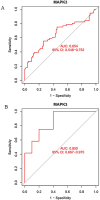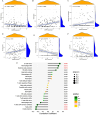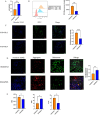Ferroptosis-related gene MAPK3 is associated with the neurological outcome after cardiac arrest
- PMID: 38885209
- PMCID: PMC11182507
- DOI: 10.1371/journal.pone.0301647
Ferroptosis-related gene MAPK3 is associated with the neurological outcome after cardiac arrest
Abstract
Background: Neuronal ferroptosis is closely related to the disease of the nervous system, and the objective of the present study was to recognize and verify the potential ferroptosis-related genes to forecast the neurological outcome after cardiac arrest.
Methods: Cardiac Arrest-related microarray datasets GSE29540 and GSE92696 were downloaded from GEO and batch normalization of the expression data was performed using "sva" of the R package. GSE29540 was analyzed to identify DEGs. Venn diagram was applied to recognize ferroptosis-related DEGs from the DEGs. Subsequently, The Gene Ontology (GO) and Kyoto Encyclopedia of Genes and Genomes (KEGG) enrichment analysis were performed, and PPI network was applied to screen hub genes. Receiver operating characteristic (ROC) curves were adopted to determine the predictive value of the biomarkers, and the GSE92696 dataset was applied to further evaluate the diagnostic efficacy of the biomarkers. We explore transcription factors and miRNAs associated with hub genes. The "CIBERSORT" package of R was utilized to analyse the proportion infiltrating immune cells. Finally, validated by a series of experiments at the cellular level.
Results: 112 overlapping ferroptosis-related DEGs were further obtained via intersecting these DEGs and ferroptosis-related genes. The GO and KEGG analysis demonstrate that ferroptosis-related DEGs are mainly involved in response to oxidative stress, ferroptosis, apoptosis, IL-17 signalling pathway, autophagy, toll-like receptor signalling pathway. The top 10 hub genes were selected, including HIF1A, MAPK3, PPARA, IL1B, PTGS2, RELA, TLR4, KEAP1, SREBF1, SIRT6. Only MAPK3 was upregulated in both GSE29540 and GAE92696. The AUC values of the MAPK3 are 0.654 and 0.850 in GSE29540 and GSE92696 respectively. The result of miRNAs associated with hub genes indicates that hsa-miR-214-3p and hsa-miR-483-5p can regulate the expression of MAPK3. MAPK3 was positively correlated with naive B cells, macrophages M0, activated dendritic cells and negatively correlated with activated CD4 memory T cells, CD8 T cells, and memory B cells. Compared to the OGD4/R24 group, the OGD4/R12 group had higher MAPK3 expression at both mRNA and protein levels and more severe ferroptosis.
Conclusion: In summary, the MAPK3 ferroptosis-related gene could be used as a biomarker to predict the neurological outcome after cardiac arrest. Potential biological pathways provide novel insights into the pathogenesis of cardiac arrest.
Copyright: © 2024 Hou et al. This is an open access article distributed under the terms of the Creative Commons Attribution License, which permits unrestricted use, distribution, and reproduction in any medium, provided the original author and source are credited.
Conflict of interest statement
The authors have declared that no competing interests exist.
Figures











Similar articles
-
[Exploration of key ferroptosis-related genes as therapeutic targets for sepsis based on bioinformatics and the depiction of their immune profiles characterization].Zhonghua Wei Zhong Bing Ji Jiu Yi Xue. 2024 Oct;36(10):1025-1032. doi: 10.3760/cma.j.cn121430-20240524-00457. Zhonghua Wei Zhong Bing Ji Jiu Yi Xue. 2024. PMID: 39586719 Chinese.
-
Identification and Validation of Oxidative Stress-Related Hub Genes in Parkinson's Disease.Mol Neurobiol. 2025 May;62(5):5466-5483. doi: 10.1007/s12035-024-04622-6. Epub 2024 Nov 18. Mol Neurobiol. 2025. PMID: 39556279
-
To establish and validate autophagy related biomarkers for the diagnosis of IgA nephropathy.Sci Rep. 2025 Apr 22;15(1):13944. doi: 10.1038/s41598-025-98591-y. Sci Rep. 2025. PMID: 40263537 Free PMC article.
-
Integrated miRNA-mRNA network revealing the key molecular characteristics of ossification of the posterior longitudinal ligament.Medicine (Baltimore). 2020 May 22;99(21):e20268. doi: 10.1097/MD.0000000000020268. Medicine (Baltimore). 2020. PMID: 32481304 Free PMC article.
-
JUN and ATF3 in Gout: Ferroptosis-related potential diagnostic biomarkers.Heliyon. 2024 Oct 30;10(22):e39957. doi: 10.1016/j.heliyon.2024.e39957. eCollection 2024 Nov 30. Heliyon. 2024. PMID: 39619595 Free PMC article. Review.
Cited by
-
Identification of Common Genes for Neuropathic Pain and Parkinson's Disease Based on Bioinformatics Analysis and Their Potential Value in the Diagnosis of Neuropathic Pain.J Pain Res. 2025 Sep 1;18:4483-4495. doi: 10.2147/JPR.S532016. eCollection 2025. J Pain Res. 2025. PMID: 40918411 Free PMC article.
-
Decoding the Tumor Microenvironment of Myoepithelial Cells in Triple-Negative Breast Cancer Through Single-Cell and Transcriptomic Sequencing and Establishing a Prognostic Model Based on Key Myoepithelial Cell Genes.Int J Genomics. 2025 May 6;2025:6454413. doi: 10.1155/ijog/6454413. eCollection 2025. Int J Genomics. 2025. PMID: 40365116 Free PMC article.
-
Bioinformatics analysis to explore biomarkers and mechanisms of action associated with endoplasmic reticulum stress and ferroptosis in Parkinson's disease.PLoS One. 2025 Aug 8;20(8):e0328682. doi: 10.1371/journal.pone.0328682. eCollection 2025. PLoS One. 2025. PMID: 40779572 Free PMC article.
References
MeSH terms
Substances
LinkOut - more resources
Full Text Sources
Medical
Molecular Biology Databases
Research Materials
Miscellaneous

